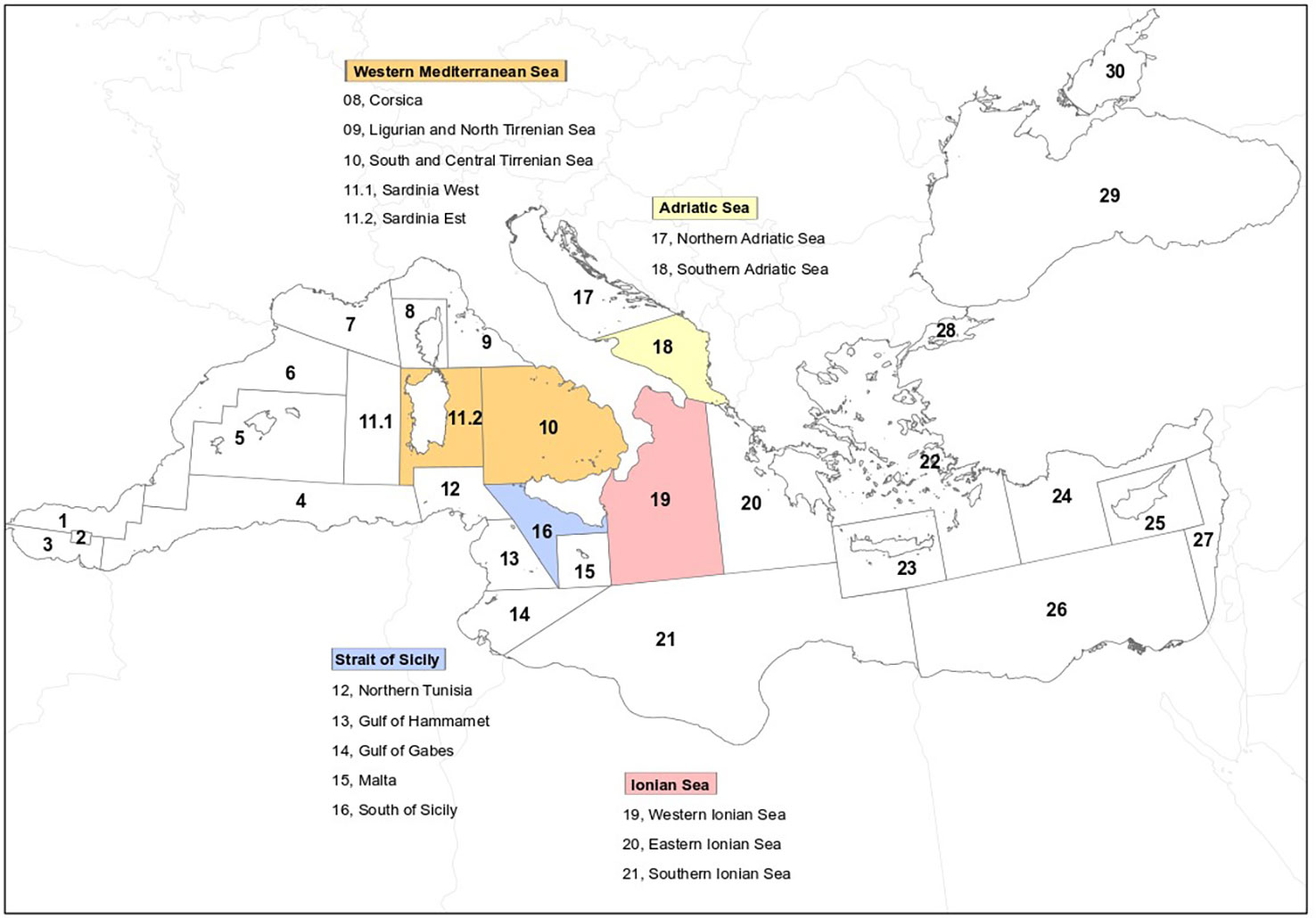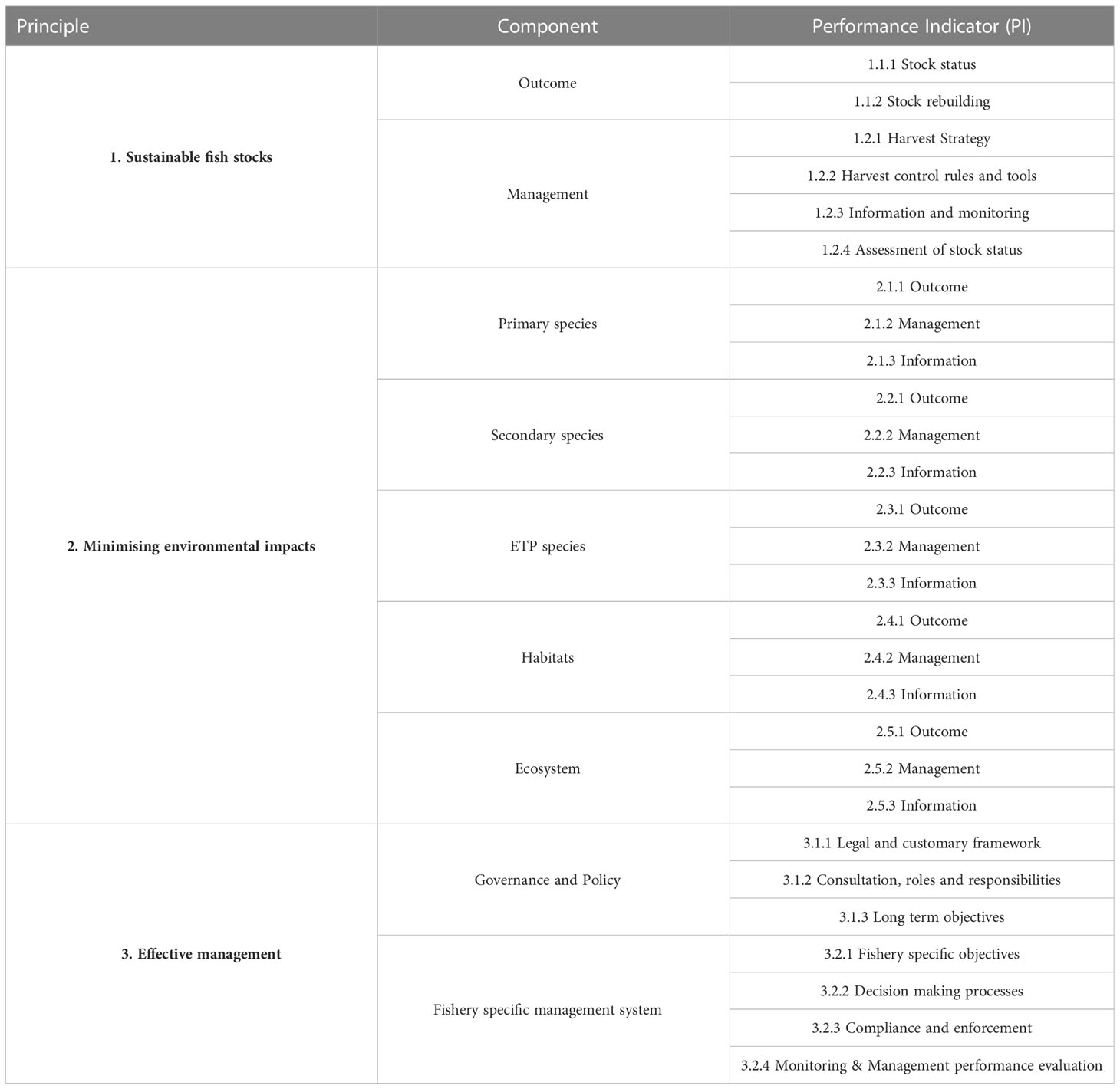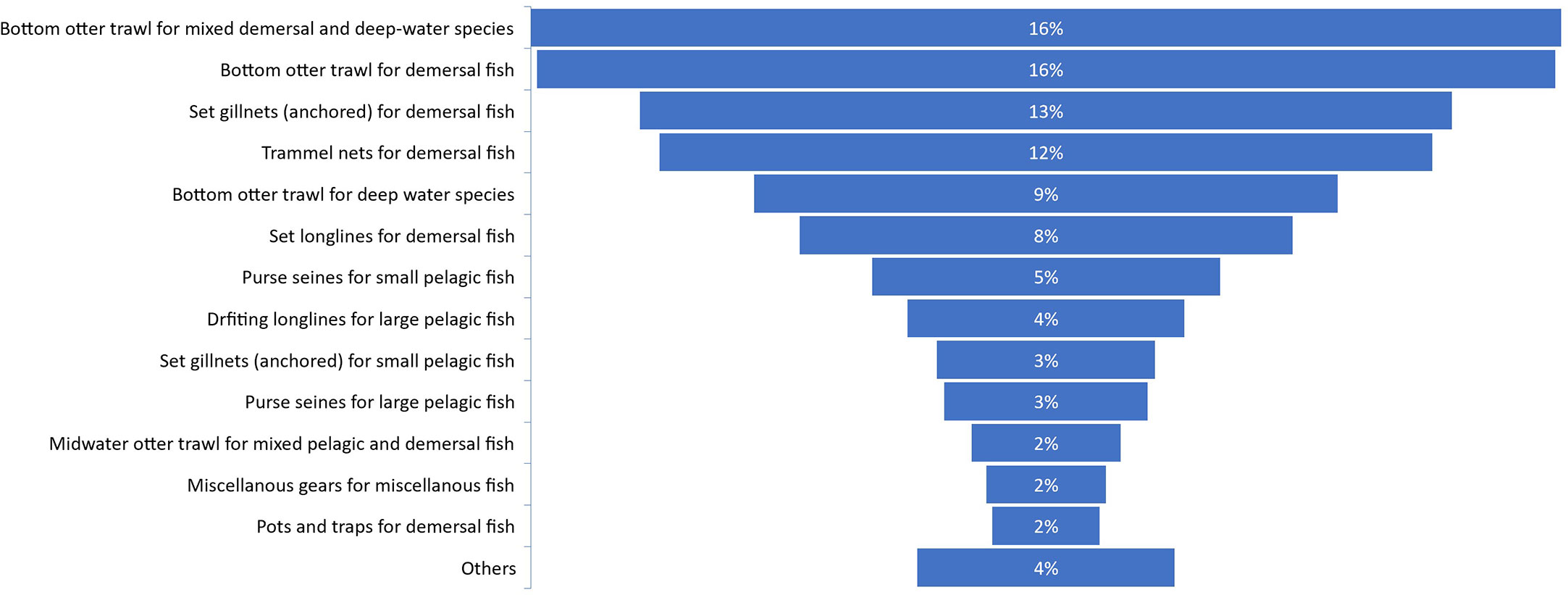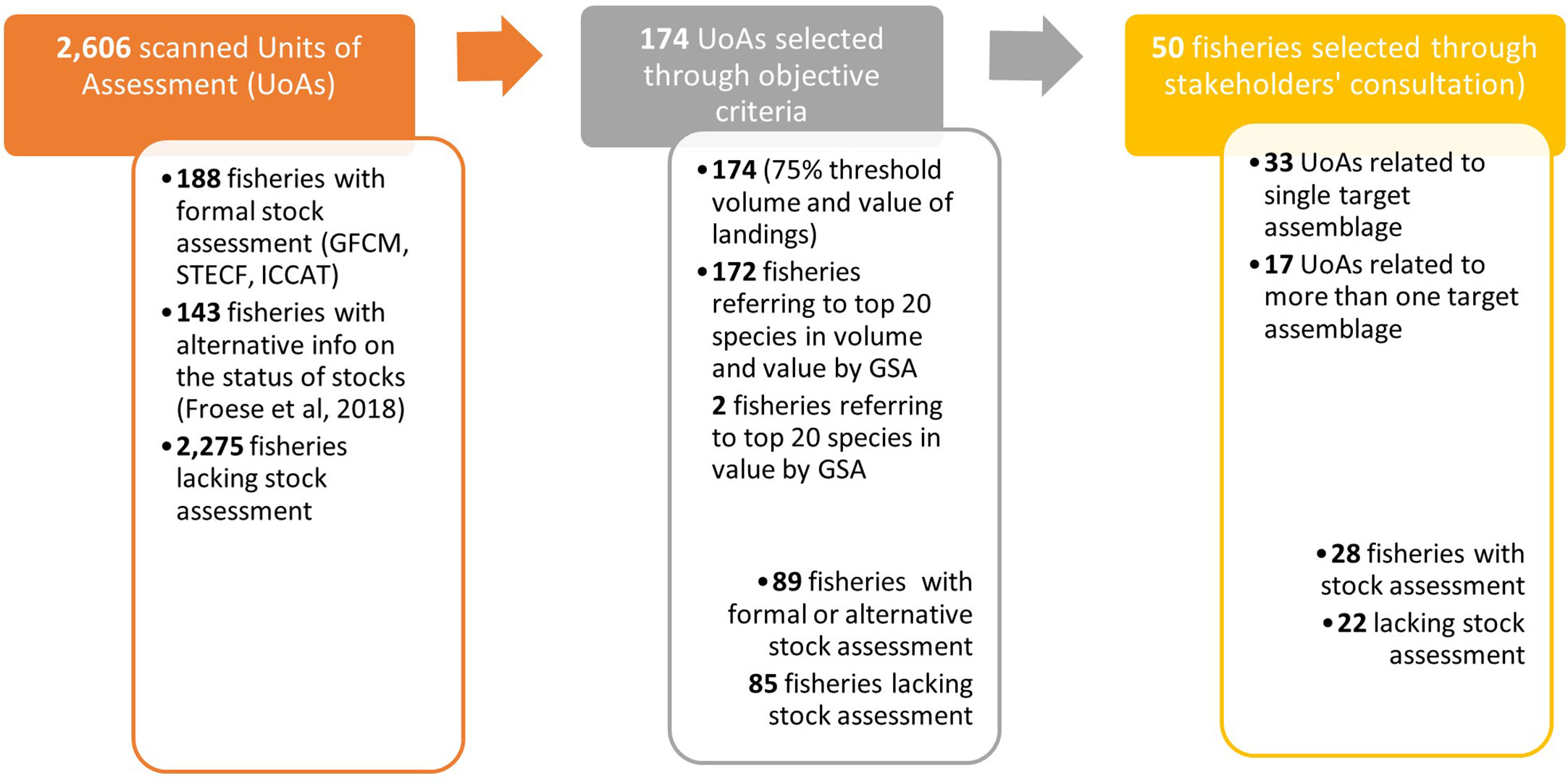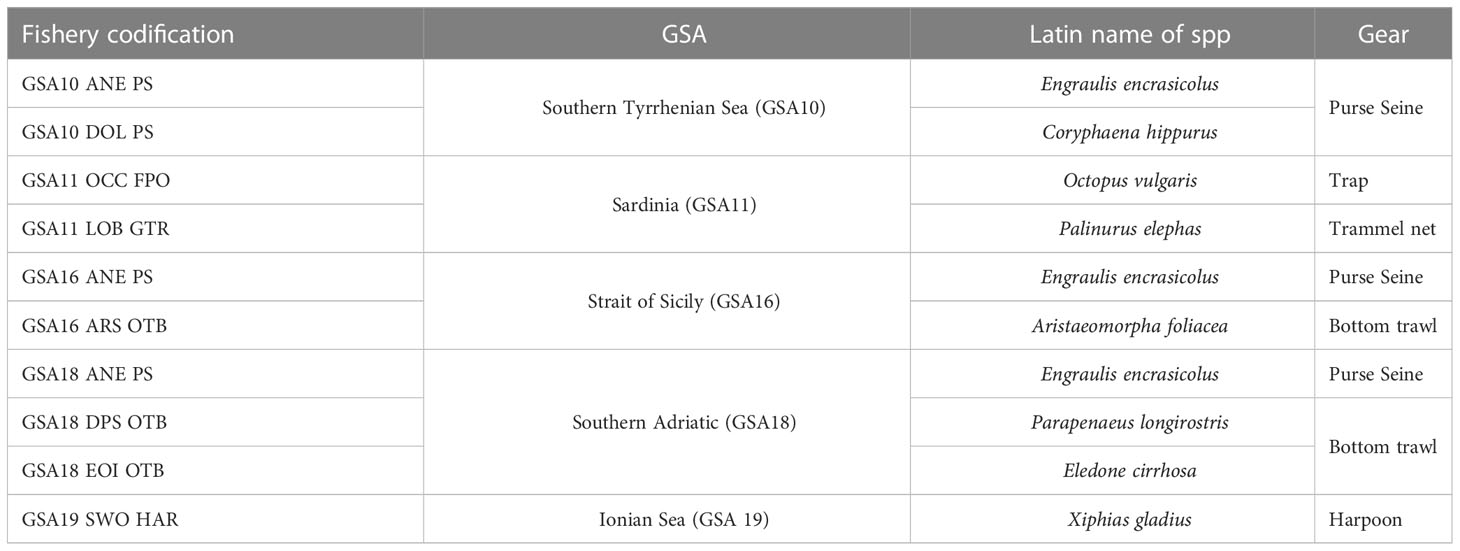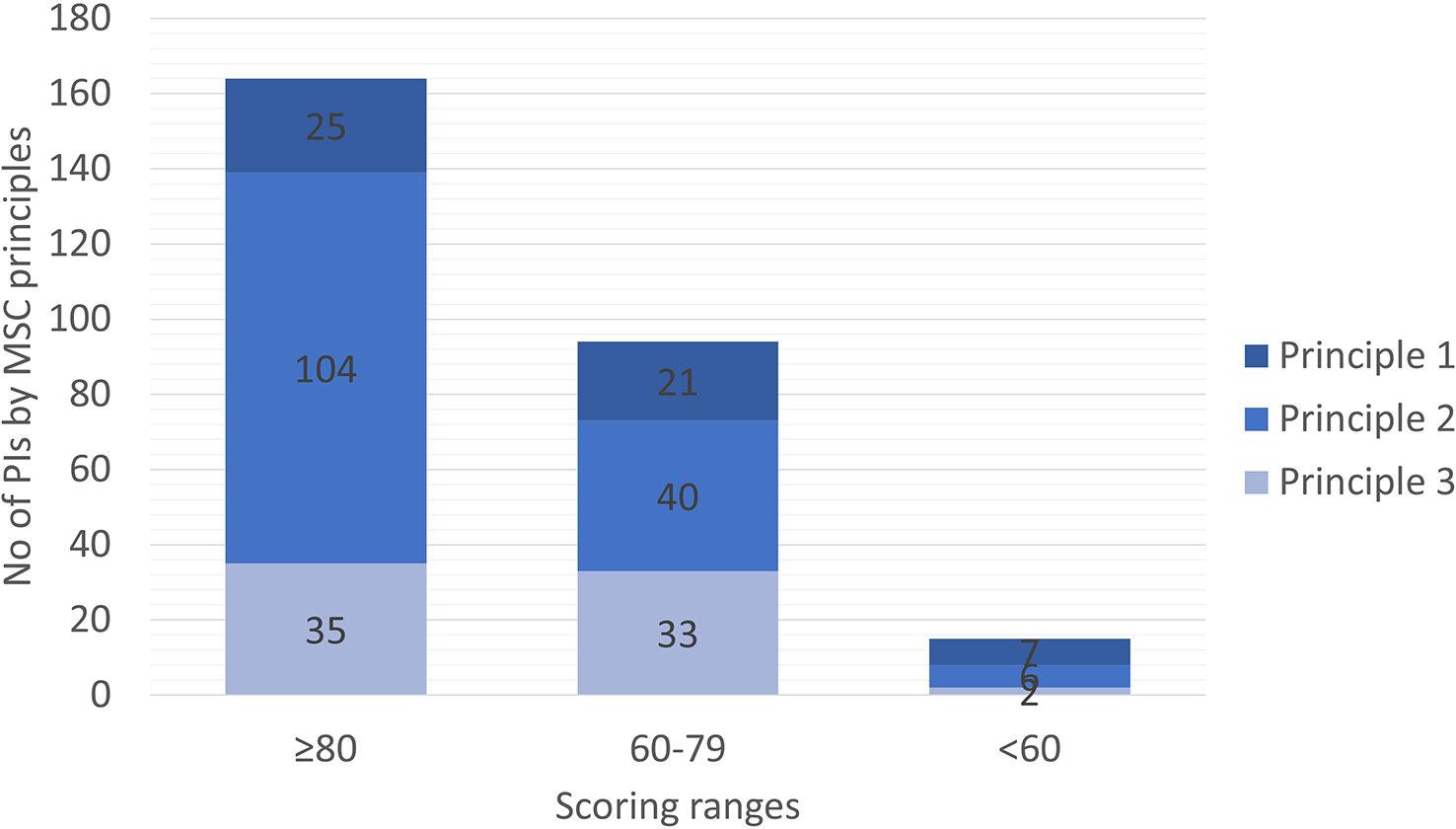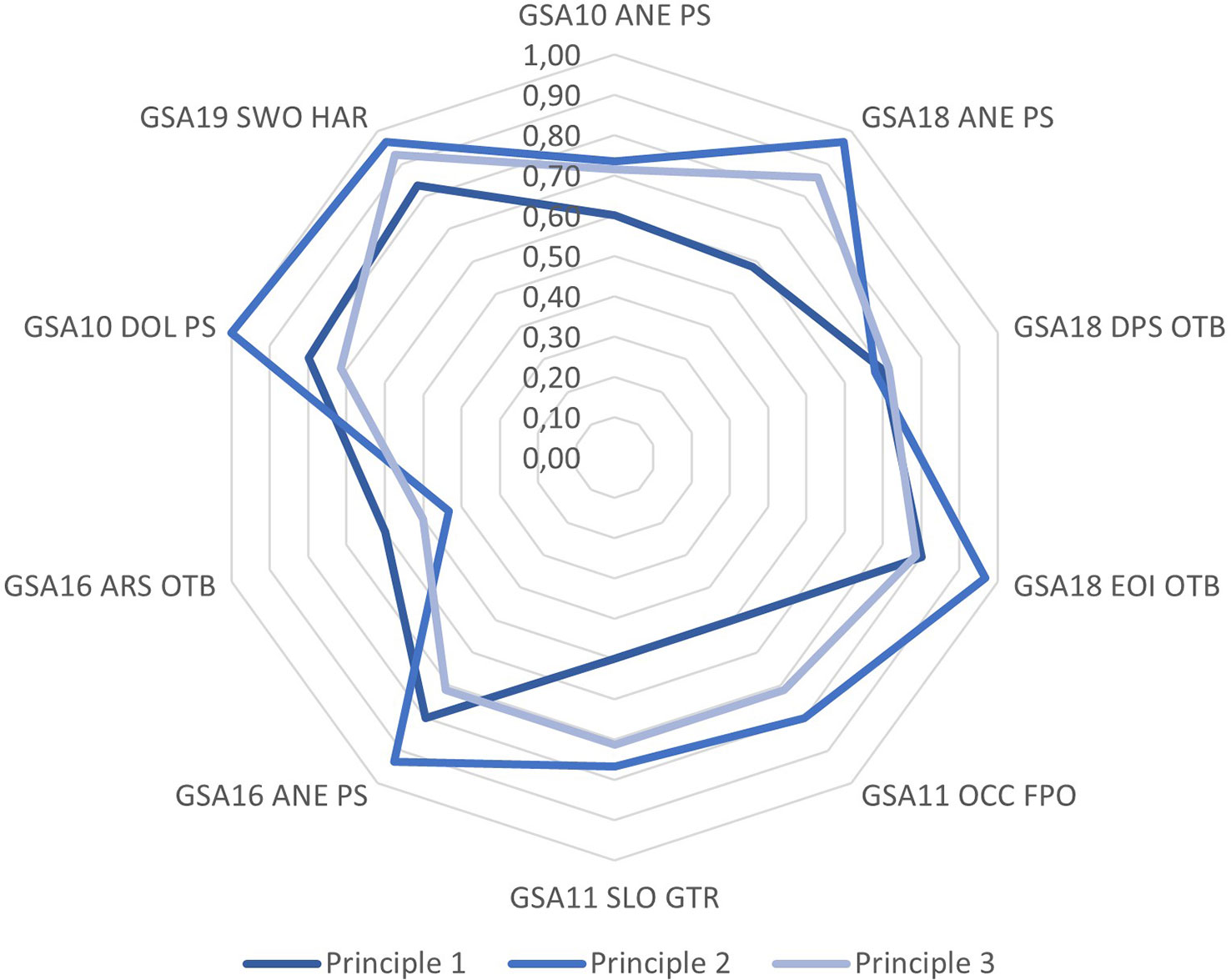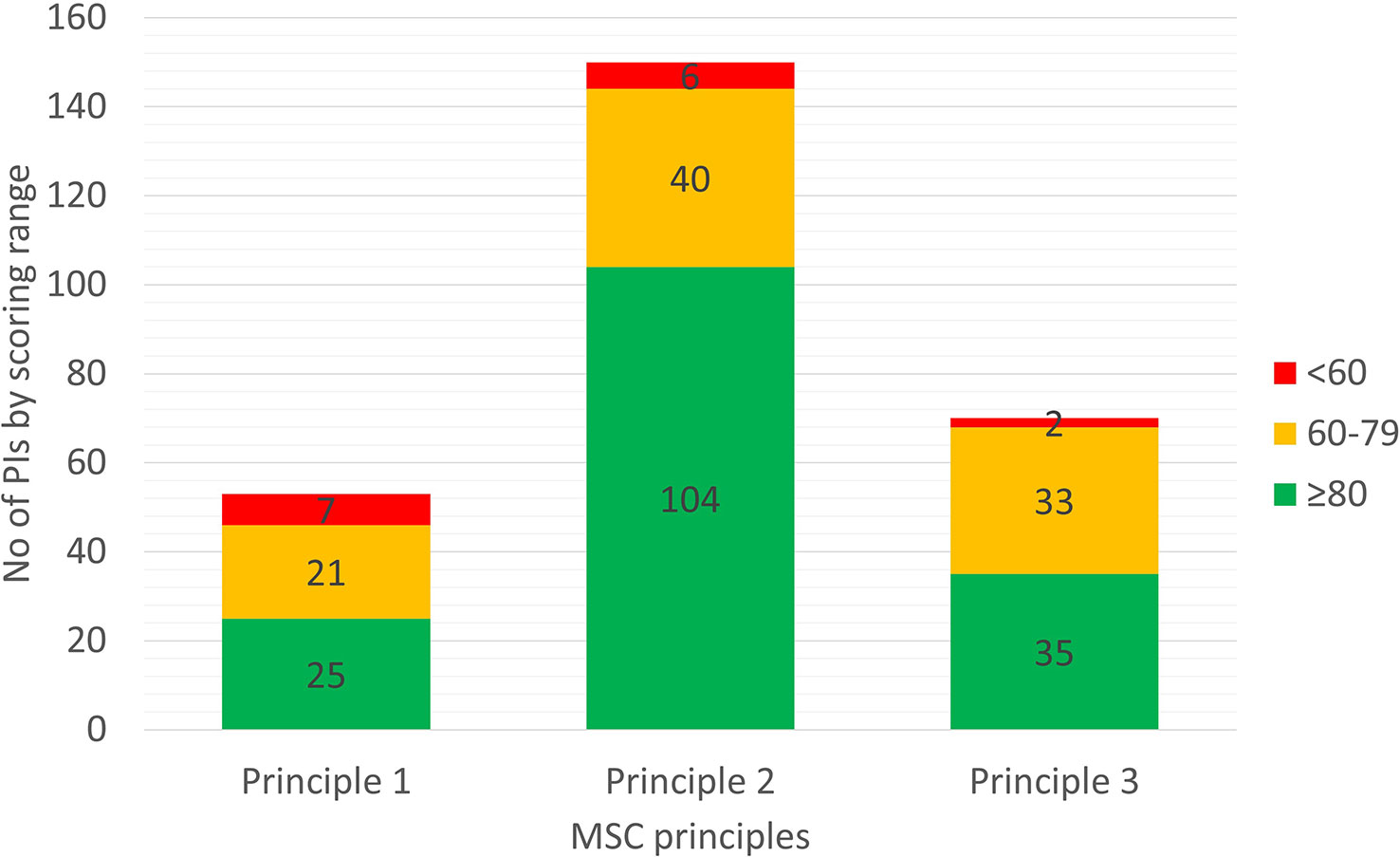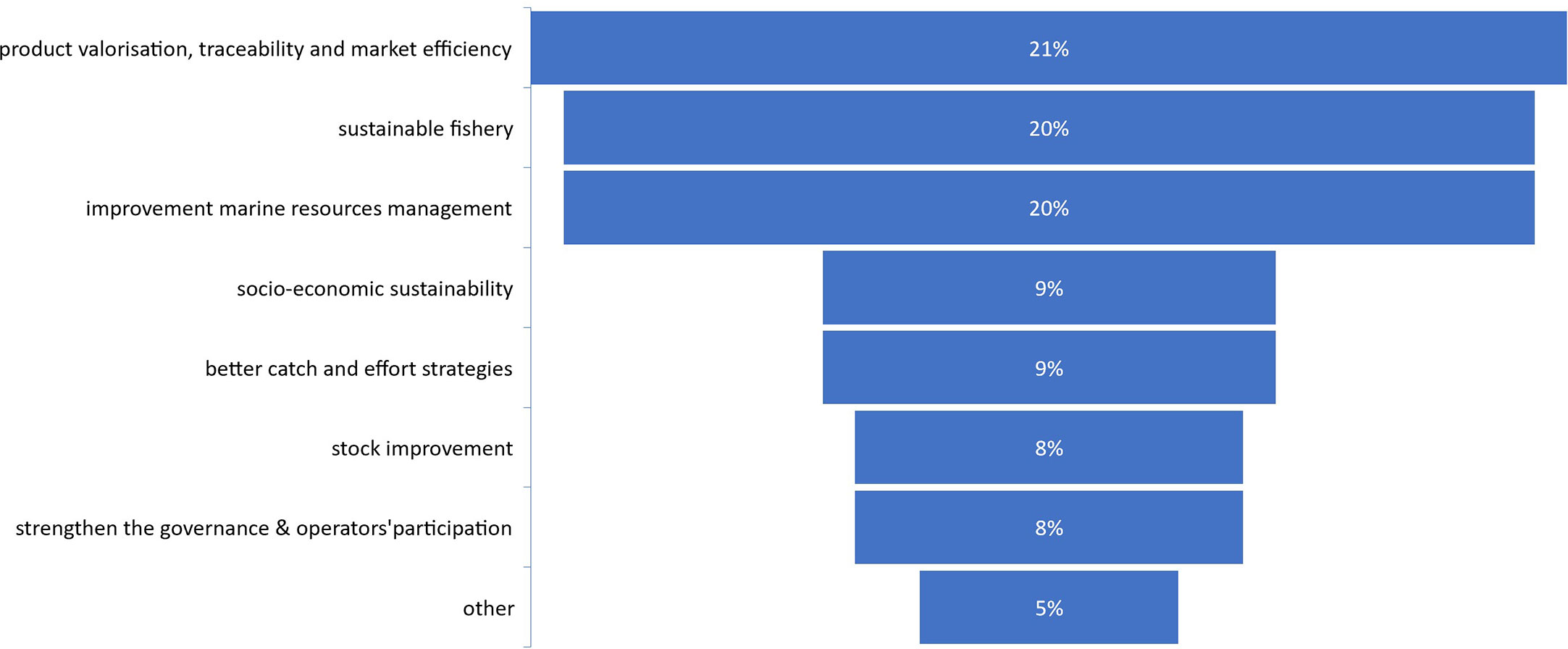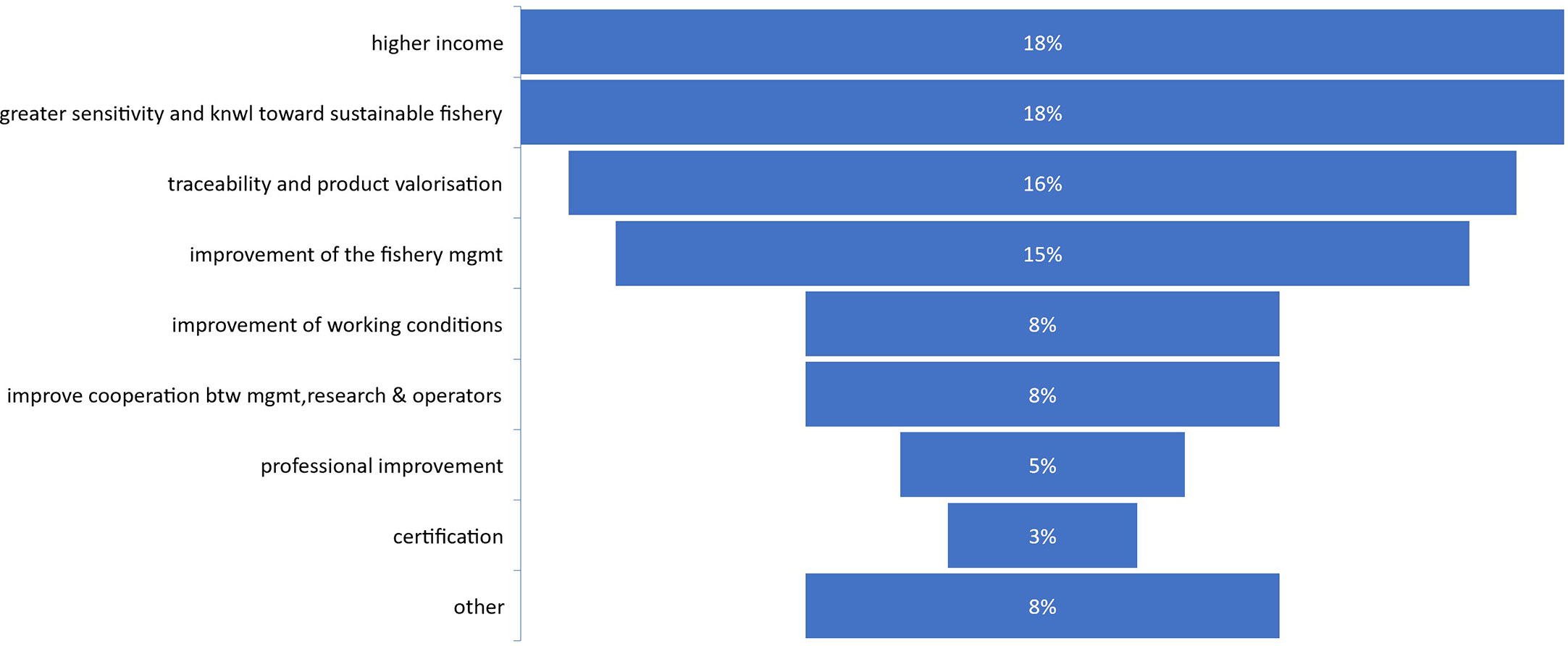- 1NISEA, Fisheries and Aquaculture Economic Research, Salerno, Italy
- 2National Research Council of Italy (CNR)/Institute for the Study of Anthropic Impact and Sustainability in the Marine Environment (IAS), Istituto per lo studio degli Impatti Antropici e Sostenibilità in ambiente marino, Capo Granitola, Italy
- 3COISPA Tecnologia & Ricerca, Bari, Italy
- 4Dipartimento di Scienze della vita e dell’ambiente, Università di Cagliari, Cagliari, Italy
- 5National Research Council of Italy (CNR)/Institute for Biological Resources and Marine Biotechnology (IRBIM), Istituto per le Risorse Biologiche e le Biotecnologie Marine, Mazara del Vallo, Italy
- 6Marine Stewardship Council (MSC) Italia, Milano, Italy
- 7Independent Researcher, Genova, Italy
- 8National Research Council of Italy (CNR)/Institute for Biological Resources and Marine Biotechnology (IRBIM), Istituto per le Risorse Biologiche e le Biotecnologie Marine, Ancona, Italy
A misalignment between the legislation and the effectiveness of Mediterranean fisheries management has emerged due to the status of the stocks (still largely in overfishing) and the discontent of stakeholders regarding management plans and tools that are not always recognized as appropriate to the characteristics of the concerned fisheries. Stakeholders’ involvement in management processes is one of the main pillars of the Common Fisheries Policy revision. The literature underlines, in an increasingly urgent manner, the importance of stakeholders fully understanding the contents of management plans and, vice versa, necessary for the successful implementation of policies. Focusing on the path towards sustainability endorsed by the BluFish project, the paper tries to provide an answer about the sustainability of some selected Southern Italian fisheries, by adopting the assessment approach of the Marine Stewardship Council. The assessment approach, based on a set of Performance Indicators and on a well-defined scoring scheme, focuses on three dimensions of sustainability. In addition to the classic assessment of the state of the stocks, there is an extensive screening of the impact of anthropic activity such as fishing on the entire ecosystem, including both the impact on accessory species and on vulnerable habitats and species. The evaluation adopted goes even further, with an approach that also includes the management and governance sphere, also trying to evaluate the level of involvement of the operators in the decision-making process. The paper illustrates that the selected fisheries are not fully sustainable but some of them have excellent potential for improvement even in the short term by identifying and implementing the appropriate action. The most relevant weaknesses identified refer to the low scores obtained for sustainability of stocks, mainly around the Harvest Control Rules (HCR) and the Harvest Strategy indicators, highlighting the importance of improving the management of the assessed stocks. The paper highlights how data and scientific knowledge availability is essential for a detailed mapping and evaluation of fishing activities but also that the path towards more sustainable and responsible fisheries does not work without a strong participation of all the key stakeholders.
Introduction
Approximately 73% of the fish stocks assessed in the Mediterranean Sea are considered to be in overexploitation (FAO, 2022a; FAO, 2022b); however, recent trends show a consistent decrease in stocks assessed in overexploitation, especially since 2012, when this percentage was 83% (FAO, 2022b). This overexploitation is the result of various factors, among which the most important is fleet overcapacity, as emerged, in the last years and especially for Italy, in the framework of STECF (Scientific, Technical and Economic Committee for Fisheries) working groups on balance between fishing opportunities and fishing capacity (STECF, 2020; STECF, 2021; STECF, 2022a). Not marginal is the role of a still lacking monitoring program. Even if improving, data availability on the status of Mediterranean stocks is, indeed, far from being optimal: without taking into account large pelagic species and considering only non-deprecated assessments (e.g. less than three or five years depending on the species) the percentage of stocks for which advice was provided on a quantitative and qualitative (precautionary) basis remained around 25 percent, (FAO, 2022b). According to the European Environmental Agency, the poorness of data collection emerges also for monitoring programs related to the evaluation of the environmental impact of fisheries (EEA, 2020). The poor involvement of the fishing sector in the decision-making process and weak market engagement in promoting the sustainable exploitation of natural resources, might have contributed to further slow the process toward sustainability of the Mediterranean fisheries. Gomez and Lloret (2017) have, indeed, highlighted a misalignment between the rules or legislation and the social practice which does not fully consider local ecological and socio-cultural specificities in the implementation of effective measures or the participation of key stakeholders in fisheries’ policies. Stakeholders’ involvement in the management processes is one of the pillars of the basic Regulation, the Common Fisheries Policy CFP (EU Reg. No. 1380/2013, Article 3, Principles of good governance, h). The literature on fisheries management underlines, in an increasingly urgent manner, the importance of stakeholders fully understanding the contents of management plans and measures adopted as well as, vice versa, the relevance of fisheries managers correctly interpreting the perceptions of the interested parties involved, which is necessary for the successful implementation of the policies (Garza-Gil et al., 2015; De Vos et al., 2016). Linke and Bruckmeier (2015) describe the importance of the co-management of fisheries developed in Europe through various experimental forms of fishermen participation in the management process, in advisory roles or through delegation and sharing of power. Higher involvement increases transparency and affects positively the interpretation of management measures, the basis for their acceptance by the fishery sector. A greater acceptance leads to higher compliance with and more effective implementation of the measures, allowing the management objectives to be achieved faster (Pita et al., 2012; Malvarosa et al., 2019).
Management authorities are beginning to use certification programs, applied to evaluate the sustainability performance of fisheries throughout the world, to provide a framework for recognizing best practice actions and for identifying and analyzing the challenges regarding the adoption of measures that can achieve improvements in fisheries management in the short and long term (Gozzer-Wuest et al., 2023). In particular, Marine Stewardship Council (MSC) standards are increasingly used before making sweeping adjustments aimed at enhancing efficiencies for all fisheries, not just those seeking certification. This multi-stakeholder, collaborative approach, which is known as the Project Pre-Assessment (PPA) or Fishery Improvement Project (FIP) models, has already been applied in Australia, Indonesia, Mexico, South Africa, Japan, the UK and, most recently, the Mediterranean region, with the aim of promoting the improvement of the sector’s management. Through a combination of fisheries mapping and pre-assessments of the fisheries performance against the certification standard, this approach offers governments, fishermen, scientists, market players and local non-governmental organizations the opportunity to collaborate in identifying the most efficient route to make environmental improvements at the most appropriate scale. The main feature of a PPA is that its intended impact extends beyond the immediate project results, aiming at improving the overall fisheries management. Cooperation between fishers, NGOs, research institutes, international agencies, administrations, public institutions, and retailers increases, indeed, the possibility of accessing the necessary resources, expands skills, strengthens the sense of responsibility of the involved actors and paves a more conscious path towards fish sustainability (Anderson et al., 2021), which may eventually lead to certification, creating further benefits for operators. Participatory methods have, indeed, demonstrated their potential to integrate ecosystem-based management in a community-based approach, involving all actors in a proactive manner and “considering fisheries as a human activity socially and culturally rooted in the environment, which would enhance the effective implementation of fisheries policies” (Gomez and Maynou, 2021a).
The first PPA experience in the Mediterranean, the Medfish project, has been carried out in the Western Mediterranean engaging fisheries in France and Spain (http://www.project-medfish.com/). Medfish has led to positive conclusions about the replicability of the PPA approach in other Mediterranean fisheries, identifying that more than half of the performance indicators of the selected fisheries’ needed improvements to reach the MSC level. Most of the improvements required were related to the impact of fisheries on the environment and to management/governance aspects of the fisheries concerned and data availability and reliability were identified as transversal weaknesses.
Building on the lessons learnt in Medfish and the main benefits gained from fisheries, its approach has been replicated, fine-tuned and further developed in certain Italian fisheries selected in Southern Italy, including the islands.
This paper highlights the main findings of the first stages of the BluFish pathway, focusing on the a) fisheries’ identification and b) their sustainability assessment, the latest carried out according to the MSC principles and standards based on the FAO Code of Conduct for Responsible Fisheries. Feeding on the available public data and on a participatory approach developed during the BluFish project, the paper tries to provide an answer to the question: are Southern Italian fisheries sustainable? If not or not enough, which actions are needed to improve the process toward sustainability? According to the MSC approach, “the sustainability of a fishery can be assessed regardless of its size, geography or the fishing method used” against three main principles: sustainability of the stocks, environmental impact of the fishery, effectiveness of fishery’s management.
At the time of writing, over 539 fisheries MSC certified worldwide (MSC, 2022), only three (3) fisheries in the Mediterranean, of which one in Italy, have been deemed to be compliant with MSC standards, thus achieving, after a “full assessment” process, the related certification: e.g. two Bluefin tuna fisheries (Spain and France) and the Venetian striped Venus clam fishery1. This proves how difficult it is, for various reasons, for Mediterranean fisheries, to access a sustainability certification. In most cases, the reason lies in the lack of an appropriate management strategy; at times, the lack of appropriate data collection is the reason. The main challenges stem from the multispecies nature of Mediterranean fisheries, where most fleets consist of small-scale vessels often catching mixed stocks with a variety of gears in the course of the same trip (FAO, 2022a). On the other hand, it is demonstrated that wild-caught fish populations targeted by MSC-certified fisheries have higher relative abundance than non-MSC populations (Melnychuk et al., 2022) as well the role of eco-certification as an important tool in addressing IUU fishing (Longo et al., 2021).
The sustainability assessment becomes crucial if we consider that the fishing activities selected for the pre-assessment phase (see the results section for details) are among the most relevant at local and national socio-economic level: the anchovy (ANE, Engraulis encrasicolus) fishery is one of the top fishery both in terms of volume and value of landings (4% and 6% of the total, respectively, in 2020); at the same time, the red shrimp (ARS, Aristaeomorpha foliacea) and the deep-water rose shrimp (DPS, Parapenaeus longirostris) fisheries are the most important, in terms of value: 8% and 7%, respectively. Spiny lobster (SLO, Palinurus elephas) is the most valued species (ex-vessel price equal to 44 €/kg in 2020) and, similarly to swordfish (SWO, Xiphias gladius), plays a key role for the economy of local coastal communities, representing, as in the case of lobster, an important share of revenues for small-scale vessels. In addition, trawling and purse seine fishing (to which 7 of the 10 selected fisheries refer) are also relevant from a socio-economic point of view, as they generate about 36% of national employment. It is also important to underline that the selected activities mainly refer to the southern Adriatic and Sicily, the most relevant areas, from a productive point of view, for the Italian fishery (STECF, 2022b).
Materials and methods
Scanning and mapping fisheries: the relevance of data collection
The sustainability assessment of the Southern Italian fisheries started with a preliminary scan of all the possible existing fisheries in the coastal areas under analysis - Figure 1.
The “fast scan” (the name of the phase under the BluFish project) built upon the identification of all possible métiers active along the Southern Italian coastline. A métier is defined as “a group of fishing operations targeting a similar (assemblage of) species, using similar gear, during the same period of the year and/or the same area and which are characterized by a similar exploitation pattern” (EC Decision 2008/949) 2. The notion of a métier is therefore closely linked to fishermen’s activities, patterns, traditions and gears. Accordingly, each métier involves a set of fishing operations characterized by a combination of fishing gear, target species, area and season, which constitute homogeneous units that supply the main characteristics of a large number of fishing trips in a single variable (González-Álvarez et al., 2016). The list of métiers of the Mediterranean Sea has been identified by the Regional Coordination Meeting for the Mediterranean and the Black Sea (RCM MED&BS, Sete, 2008) and is available on the website of the European Data Collection Framework 3. For practicality, the level of métier used for the present study was level (5), covering gear type and target assemblage, independently from the mesh size dimension. The “fast scan” substantiated the identification of all combinations of area/métier/species, where the area refers to the geographical sub-area (GSA) as defined by the General Fisheries Commission for the Mediterranean (GFCM) with the Resolution FCM/33/2009/24, replying to the need to compile data, monitor and assess fisheries resources in a georeferenced manner, by identifying appropriate boundaries for Mediterranean fishing areas. For each GSA and species, the status of the stock (where available) was reported, using information obtained from various databases (mainly STECF, GFCM, ICCAT.), reporting the information in terms of F/FMSY (F = fishing mortality; FMSY = fishing mortality at the maximum sustainable yield [MSY] level). Biomass reference points were also reported, if available.
The mapping phase was complemented by the identification of the most important fisheries according to two objective criteria:
1. fisheries where the relevant species was a target species and
2. the target species being among the 20 most important species by volume and value of the related GSA.
The first criterion was a scientific method validated by the STECF, which considers the 75% threshold of the cumulative value and volume of landings (STECF, 2015). This approach was originally developed by the STECF in support of the scientific advice to the CFP, in particular to address the EC request for supporting the implementation of the landing obligation regulation and has been employed to identify the main European demersal fisheries in the Mediterranean. By accessing the data on the volume and value of landings collected under the Italian national program for the fishing sector5, publicly available on the Joint Research Center website6,the 75% threshold of the cumulative value and volume of landings (sum of the values of the two years 2015–2016, available at the starting time of the study) was used, for each fishery and gear combination in each GSA, to identify the most represented taxa.
Once the “target fisheries” have been classified using the threshold criterion, the top-20 fisheries by volume and value of landings (sum of the values of the two years 2015–2016) have been identified for each GSA.
The sustainability (pre-)assessment
The sustainability assessment of fisheries that carried out during the BluFish path was, actually, a “pre-assessment”, according to the MSC terminology. In a standard certification process, the main aim of the (sustainability) pre-assessment of fisheries is to define areas that may require additional data or improvements before a “full assessment” is undertaken. Considering that the ultimate goal of the BluFish path is the creation of an enabling environment for the sustainability and effective management of fish resources, the MSC pre-assessment approach was used to identify areas of improvement to accompany the fisheries, step-by-step, towards a more sustainable state.
MSC defines a standard approach for the pre-assessment of fisheries willing to check if it is possible to conduct a more in-depth sustainability evaluation leading to certification. The pre-assessment follows the MSC standards, consisting of three principles (Principle 1: sustainable target fish stocks, Principle 2: environmental impact of fishing and Principle 3: effective management) and 28 related performance indicators (PIs) - Table 1.
The pre-assessment process involves scoring all PIs using narrative guides focusing on specific aspects of the fishery (called scoring guideposts [SGs]). There are 28 performance indicators that sit under the three principles of the MSC Fisheries Standard. The fishery is assigned a score for each performance indicator, where 60 is the minimum acceptable performance, 80 is global best practice and 100 is state of the art performance. To become certified, the score must be at least 60 for each of the 28 performance indicators. If it scores between 60 and 79 for any of them, the fishery will be required to take appropriate action as a condition of certification, improving the performance so that it scores 80 or above for each indicator within 5 years maximum. Additionally, the fishery must have an aggregate weighted mean score of 80 or higher for each of the three aforementioned principles to be certified.
In some cases, when sufficient quantitative data are not available to score a given PI using the usual set of SGs, a risk-based framework may be used. This tool uses a precautionary approach to estimate aspects such as stock status (Principle 1) and impacts on bycatch and habitats (Principle 2) when conventional data, including reference points derived from analytical stock assessment models, doesn’t exist, but is not deployed for Principle 3. As the aim of the pre-assessment is not necessarily the certification per se, the results of the scoring were used to identify areas needing improvements in terms of sustainability (i.e. PIs not reaching a score of 60), with the aim of developing an improvement plan of actions.
Each PI has then associated scoring issues that can be scored against SG60, SG80 or SG100. For example, indicator 2.3.2 (ETP species management strategy) had 5 Scoring issues: a) Management Strategy in place (national and international requirements), b) Management Strategy in place (alternative), c) Management Strategy evaluation, d) Management Strategy implementation and e) Review of alternative measures to minimize mortality of Endangered, Threatened and Protected (ETP) species.
To better explain the rationale behind the scoring process, it is worth mentioning that one of the fisheries subjected to assessment scored a SG80 for Scoring issue c) Management Strategy evaluation, as there was an objective basis for confidence that the measures/strategy would work, based on information directly about the fishery and/or the species involved. However, no detailed quantitative analysis had been carried out to assess the impact of fishery-related mortality on turtles and cetaceans and a quantitative analysis of the effectiveness of the strategy had thus yet to be carried out, not meeting SG 100. On the other hand, another fishery didn’t meet the minimum scoring of 60 for this same PI (2.3.2) and Scoring issue - c), Management Strategy evaluation - as there was a lack of management measures that could positively affect some of the shark species identified, not being able to determine that measures were considered likely to work, based on plausible arguments.
The participatory approach: selecting fisheries, identifying improvement actions and checking expectations
The sustainability (pre-)assessment was conducted for a selected number of fisheries, to identify areas that need improvement actions along the path toward sustainability. The feedback from key stakeholders was gathered through a step-by-step consultation process. The selection was carried out while paying particular attention to the following criteria:
● being knowledgeable about the fisheries under evaluation
● possessing expertise in the status and biology of the target stock
● representing or being in key organizations long enough to have observed a before-and-after change
● being able to speak on behalf of the stakeholder group they represent
● representing diverse perspectives regarding the stakeholder type
Based on this, fishermen, scientists, producer associations and Fisheries Local Action Groups’ (FLAGs) representatives, representatives of control agencies, etc.…were involved in the process. First of all, key stakeholders were consulted for the selection of fisheries to be assessed in terms of sustainability. This phase was conducted between September and October 2018, through workshops, face-to-face or telephone consultations or attendance in key local events for the fishery sector. The GSAs focus of the BluFish path encompasses fishing ports of different Italian administrative regions of Southern Italy and the islands. Some GSAs are wider, covering more than one administrative region; therefore, multiple consultations were held in some regions. To discuss the selection of GSA 18 fisheries, at the end of September 2018, two workshops were organized in Apulia, in the Adriatic towns of Manfredonia and Bisceglie – two ports characterized by the relevance of demersal trawling fleets. The consultations with stakeholders from Sardinian fisheries (GSA 11) were carried out via telephone. Sicilian stakeholders were consulted at the beginning of October 2018 for the three GSAs related to the Sicilian coast (10 for the Northern coast, 16 for the Southern coast and 19 for the Eastern/Ionian coast). These consultations were realized through a workshop organized ad hoc in Palermo, with the support of a local key stakeholder, playing a key role in the Sicilian and national fish processing sector. Another consultation was held by gathering stakeholders for a workshop along a well-known event organized yearly in Mazara del Vallo – the Blue Sea Land conference. To cover all the fishing ports of GSA 10, representing the waters of the Southern Tyrrhenian Sea, in person consultations were carried out in Campania, along a national event organized for FLAGs organized in Cetara, a port of the Salerno Gulf, relevant for both small and large pelagic fisheries. Additional stakeholders from Calabria were consulted via telephone for both the Tyrrhenian and the Ionian sides.
In all the consultations, the stakeholders were requested to provide their perceptions or opinions on different aspects, among which the most important concern: a) the market of the target species – local, national or foreign? b) if there is interest from the market (and consumers) in sustainable products; c) how and how much does the management system support the identified fishery d) how relevant is the fishery from a socio-economic perspective at the local or regional level (including related industries, such as processing and catering).
In a path towards sustainability, it is also important to test, at a certain stage, the expectations and main concerns of the stakeholders regarding the path itself. Knowledge of stakeholders’ expectations, mainly that of fishers, is crucial to understand if, e.g., additional training is required. The perception of sustainability is, indeed, not always unique among stakeholders. It is rather common that sustainability paths carried out under the aegis of certification bodies are often linked directly to the possibility of gaining certification as this means, especially for fishers, new markets, premium prices and higher incomes. Nevertheless, it is also essential to identify the expected concerns of the stakeholders regarding the path, as these could act as obstacles, hindering the concerned fisheries’ pathway to sustainability. To this aim, the stakeholders’ feedback for fisheries showing an early and likely interest to undertake improvement actions, if needed, was gathered using a questionnaire containing a set of simple questions, 28 in total (Supplementary Material/Annex A), which covered topics ranging from what they expected from the improvement of their fisheries, in terms of benefits, on a personal basis and for the fishing community as a whole to their main concerns about the success of the path. Due to the Covid-19 health restrictions, the questionnaire interviews were performed by a web-based survey, providing respondents with assurance of the confidentiality of the information collected. The number of stakeholders interviewed, by category and by years of experience/involvement in the sector, is reported in Figure 2 (left side).

Figure 2 Stakeholders consulted in the test of expectations from the BluFish sustainability path (left) and in the action plans’ development (right) phases.
The participatory approach has played a crucial role also in the post-assessment phase, for the identification of the most appropriate actions that could lead the selected fishery towards a higher level of sustainability overcoming the current, if any, unsustainability of fisheries (“action plan development”). Improvement actions have been identified for the selected fisheries and action plans have been agreed for some of them by means of focus groups (Finch et al., 2014) organized for each selected fishery. The workshops, which were organized physically or virtually between September 2020 and June 2021, tackled the objective of presenting the results of the pre-assessment to the stakeholders and creating a space for the participating groups to give clarifications, provide more information and validate the analysis of the strengths and weaknesses identified during the pre-assessment. A total of 91 individuals were involved in the workshops, including the facilitators (two – the same for each consultation) and action plan requesters on behalf of the local fisheries. Most of the participants were fishers (48%) and representatives of cooperatives (2%) or fishers’ associations (5%). The research area was also significantly represented (21%). Representatives of the administration were represented by governors of the local administrative regions (7%) or by persons in charge of fisheries control (3%, coast guard). In a few workshops, individuals from fishery ancillary activities were also involved, as they had a high interest in the sustainability path (i.e. processors or Ho.Re.Ca. representatives) - Figure 2, right side.
It is worth noting, however, that authors have not been able to evaluate the final results of this last phase of the BluFish path as some of the Action plans are still in a draft version and those validated by stakeholders are at a very early stage of implementation.
Results
Scanning and selecting fisheries
The scanning methodology resulted in the identification of 2,606 fisheries - combination of GSA/métier/species or Unit of Assessment (UoAs) in the MSC terminology - in Southern and Central Tyrrhenian Sea (GSA 10), Sardinia (GSA 11), Strait of Sicily (GSA 16), Southern Adriatic Sea (GSA 18) and Western Ionian Sea (GSA 19). These fisheries represented 154 species, 12 target assemblages and 16 gears. Demersal and deep-water fisheries represented the vast majority (77%), with bottom trawling dominating (41%) with regard to the gears used. Set gillnets and trammel nets were used in 28% of the UoAs mapped, mainly for demersal fisheries. The use of pots and traps was limited to 2%. Purse seiners were used in 8% of the UoAs for small pelagic fish (Figure 3).
A preliminary examination indicated that official stock assessments (GFCM, STECF, ICCAT) were available only for the target species of 188 (7%) UoAs; alternative sources (Froese et al., 2018) provided further information on 143 additional UoAs. The complete dataset is reported on the Supplementary Material/Annex B.7 The results of the “fast scan” were then processed by applying the 75% threshold approach illustrated in the methodological section, with the aim of producing the initial list of fisheries to be further “mapped”. All combinations of GSA/gear/target assemblage/species were plotted by highlighting the “main” target species (i.e. those falling in the 75% threshold of the cumulative volume and value of landings). The plot for the small pelagic fisheries by purse seines in GSA 11 is illustrated in Figure 4 while all the plots are reported in the Supplementary Material/Annex C. In all the plots, the change in the slope of the cumulative value and volume of landings is also reported to provide detailed information on catch composition.
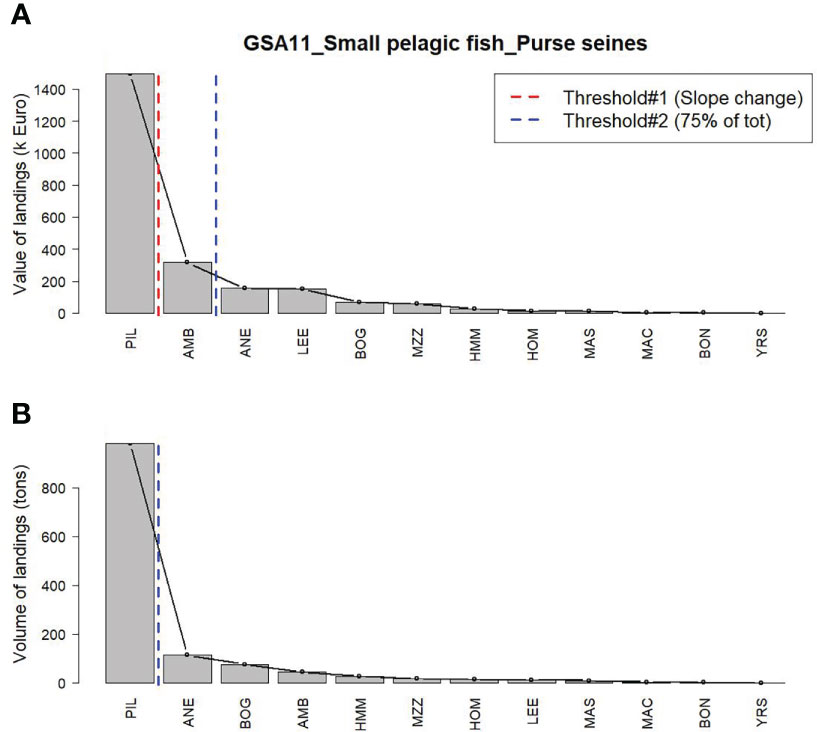
Figure 4 Plot of the cumulative value (A) and volume (B) by species (accoriding to FAO 3 Alpha Codes) for the small pelagic fisheries by purse seines in the GSA 11 (Sardinia).
As illustrated in the methodological section, further sorting was performed by selecting the main fisheries (identified by the 75% threshold approach) falling in the top 20 species by volume and value in the years 2015–2016.
The application of the two aforementioned criteria resulted in the identification of a list of 174 UoAs, distributed differently by GSAs and over different techniques and species. As mentioned in the methodological section, this preliminary list of 174 fisheries represented the base list for the identification of fisheries to be evaluated in terms of sustainability according to the MSC standards for pre-assessment. These 174 fisheries were further screened by checking, with the help of stakeholders, the existence of certain features/attributes. This phase resulted in the identification of 50 fisheries (Figure 5). The list of the 174 fisheries with the results of the two levels of selection (1) objective criteria and 2) stakeholders’ consultations) is reported in Supplementary Material/Annex D.
The final selection of the 10 fisheries (Table 2) to be subjected to the sustainability evaluation was driven, in addition to budget constraints, by the need to investigate the sustainability potential for different fisheries (e.g. cover different ports, areas, techniques, species) and, condictio sine-qua non, by the existence, on the side of the sector, of the concrete availability of fishers to be engaged in a (pre-)assessment process.
Sustainability evaluation: the (pre-)assessment results
The pre-assessed fisheries were proven to rely on good practices (around 70% of the PIs scoring >= 80, as shown in Figure 6). Only 4% of the PIs reported a score below 60, representing a critical situation. It is worth noting that the overall number of PIs is not merely equal to the sum of 280 (28 PIs foreseen by the MSC approach times the number of pre-assessed fisheries). The BluFish pre-assessment resulted, indeed, in a total of 273 PIs considering that the PI 1.1.2 related to “stock rebuilding” is scored only if the target stock is overexploited. As a result, this aspect was assessed only for ANE PS GSA18, SWO HAR GSA19 and SLO GTR GSA 11, where a plan was required to rebuild the stock.
On examining the synthetic but specific results for each fishery, a very heterogeneous performance was observed in the pre-assessment (Figure 7). By converting the evaluation of each PI in a numerical range from 0 to 1 (with <60 = 0, 60–79 = 0.50 and >= 80 = 1), it can be observed that better scores were recorded for the evaluation of Principle 2 aspects (environmental impact), with the average score for all the fisheries being 0.88. This was followed by Principle 3 (fisheries management), with an average score of 0.75. Principle 1 (stock status) had the lowest scores (0.71), highlighting the urgent need for Mediterranean fisheries to pursue improvement policies in the management of fish stocks.
When specific fisheries are considered, the swordfish fishery with harpoon had the highest score globally (0.93), being a fishery characterized by high selectivity and stocks managed by means of quotas. In contrast, the red shrimp trawl fishery had the lowest score (0.48) because of the lack of information on target species (need to improve the stock assessment) and secondary species and vulnerable species, as well as in terms of governance. In general, the scores recorded for Principle 1 remain at a lower level in comparison to Principles 2 and 3, highlighting the clear need for Mediterranean fisheries to improve their stock management (Figure 8).
Evaluating the expected benefits and concerns of a path towards sustainability
This “check” was performed with some of the fishers/stakeholders involved in two fisheries: the deep-water rose shrimp fishery with bottom trawlers in Southern Adriatic (GSA 18) and the anchovy fishery with purse seiners in the Southern Tyrrhenian Sea (GSA 10). A total of 32 stakeholders were interviewed during the first semester of 2021. The majority (72%) were represented by fishers or their representatives (fishery associations and LAGs); the remainder comprised representatives of marketing or processing activities as well as researchers.
Seven main groups of expected general benefits for the fisheries as a whole were identified, with 76 mentions in total (Figure 8). The valorization of the products, along with an increase in market efficiency, was the most mentioned group of benefits (21%) that should be achieved, through improvements in traceability, labelling and advertising campaigns aimed at emphasizing the sustainability of the product (Figure 9).
At the second level, the stakeholders expected to achieve a more sustainable fishery (20% of mentions) from the path, especially the stakeholders of the pink shrimp fishery, who expressed a strong need for a concrete and operational path towards sustainability in terms of shared rules for the Adriatic Sea. The improvement of marine resources’ management was the second most expected benefit; based on the opinions of all the stakeholders, the management might be improved with more tailored policies for the environment and the conservation of biodiversity. Only 9% of the stakeholders mentioned the improvement of long-term socio-economic sustainability and the adoption of different catch and effort strategies tailored to the specificity of each fishery (e.g. individual effort quota for the shrimp fishery, catch quota for the anchovy fishery). The improvement of the stocks’ status was mentioned in 8% of the replies, while another 8% of respondents called for a better governance structure and higher involvement of operators’ participation in the decision-making processes. the remaining 5% of responses related to miscellaneous replies.
Nine main groups of expected personal benefits were identified, with 61 mentions in total (Figure 10). The mentions (equaling replies) were lower than those for the general benefits, as personal benefits were expected only by fishers – the actors that could gain direct benefits from the path towards sustainability. The potential to earn a higher income was one of the two most expected benefits (with 18% of mentions), The other most mentioned benefit was the potential to gain greater sensitivity and knowledge of what a sustainable fishery is, in both environmental and socioeconomic terms; this was also connected to an improved understanding of the concepts underlying sustainability. Furthermore, 16% of the respondents called for an increase in the product quality (e.g. higher size) and, as a consequence, higher market value (product valorization); they also expected improvements in the traceability process. Another 3% of the replies stated that the main expectation was to gain certification, which is viewed as a valorization tool capable of producing a premium price and, hence, higher earnings.
At the personal level, there was also a strong expectation (15%) of improvements in the current management, highlighting fishers’ need for a better comprehension of management tools and the decision-making process behind their implementation. In addition, 8% of fishers called for better working conditions, in reference to the improvement of the social well-being of people living on fishery. Another 5% expected a personal improvement in terms of professionalism. For another 8% of respondents, the opportunity to be more involved in the sustainability path would lead to a careful biological monitoring and scientific data sharing, and therefore to a deeper understanding of the resource status and better cooperation among the management, researchers and the sector.
On the other hand, seventeen main groups of expected concerns were identified, with 37 mentions in total (Figure 11). The main problem concerns the real possibility of new fishermen involvement in the process (other than those already actively participating in the path), which would also imply a change in their mindset and, consequently, in fishing practices (19% of mentions). The second most common issue (14%) concerns cooperation with institutional stakeholders, as the fishing sector is still perceived as managed by a top-down approach, with marginal involvement of fishers in the decision-making process (11%). The lack of confidence in ground-up actions was the fourth most cited issue (8%), which was strongly linked to the fear that the path could be an obstacle due to (low) compliance with rules (8%). For 5% of respondents the low level of compliance is due to the excessive degree of stringency of the current rules. Two respondents (5%) also reported concerns about the management of shared resources; this was particularly felt in the Adriatic, whose stocks are under the legislative power of the EU and GFCM. The market capacity to perceive the new brand and, consequently, to accept higher sales prices – in the event that the fishery reaches the certification step – was also mentioned twice. Another set of nine miscellaneous replies should be highlighted, as they concerned the fear that the current crisis in the sector (which is also related to the need for modernizing production and processing activities) could prevent other fishers from undertaking the path. Other concerns, with one mention each, included the need to raise awareness among operators and to conduct more in-depth training for them, the poor quality of the scientific data collected, the proper communication of rules, the efficiency of the management and general skepticism regarding the sustainability approach.
Tentative improvement actions
Because of budget and time constraints, improvement actions were identified, and complete action plans were drafted only for 6 fisheries: GSA 10/European anchovy/purse seine, GSA 18/deep water rose shrimp/bottom trawling, GSA 11/common octopus/trap, GSA 11/common spiny lobster/trammel net, GSA 16/European anchovy/purse seine and GSA 16/giant red shrimp/bottom trawling. Only 3 of these action plans have finally been validated by stakeholders and these are, at the time of writing, at a very early stage of implementation8.
On the 6 action plans drafted, a total of 219 actions were identified to accompany the fisheries towards sustainability. The majority (43%) of areas needing improvements were those aspects related to the “management and status of the stock” (Figure 12). The main actions planned to tackle these gaps concern improvement in the monitoring systems, the revision of the current fishing strategy, of stocks’ rebuilding plans (for some stocks). A weakness common to all fisheries concerns the lack of up-to-date data, in particular for stock assessment as well as “old” or absent management plans (Table 3).
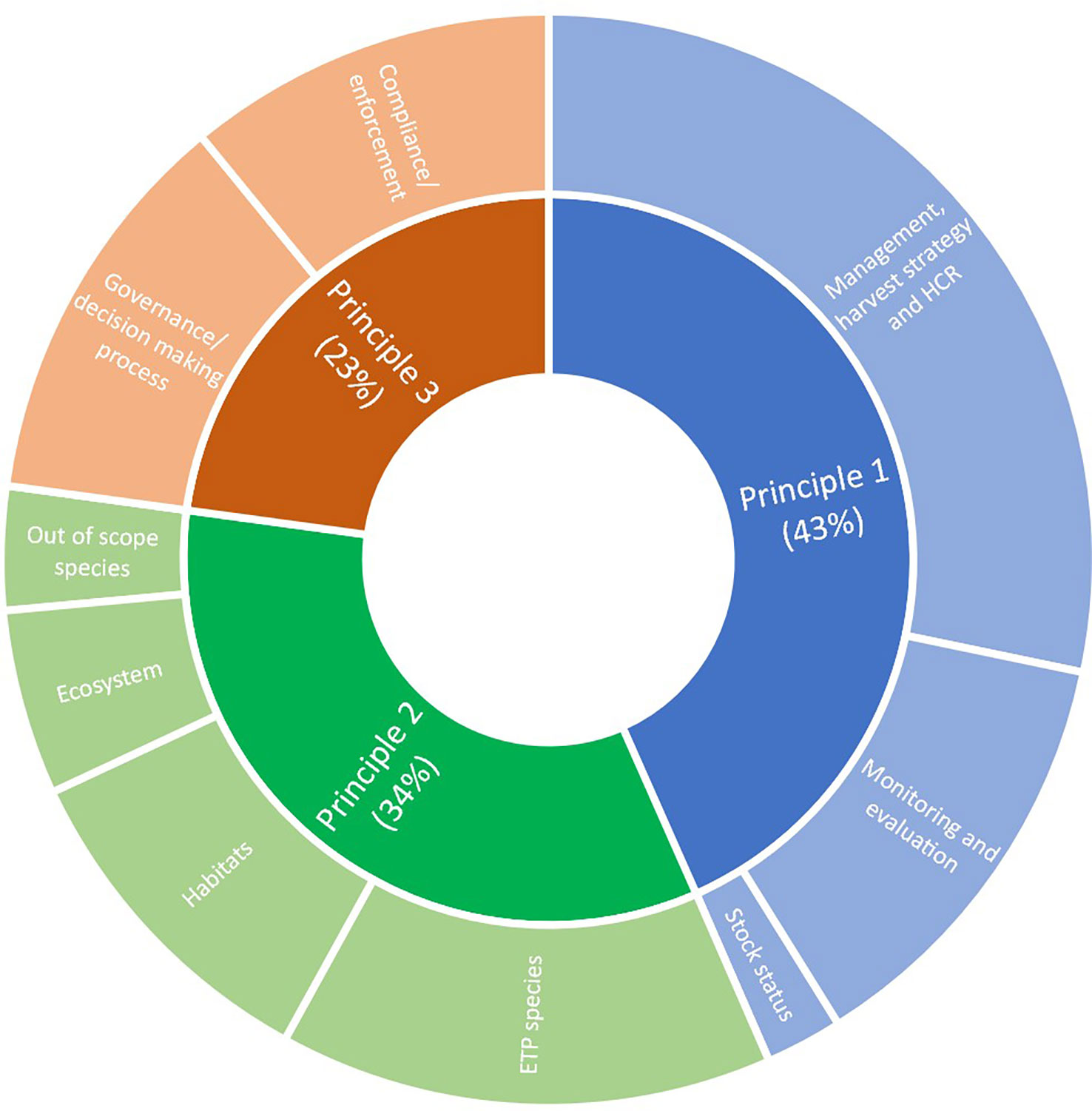
Figure 12 Distribution of improvement actions by principle and main areas of intervention (fisheries concerned GSA10 ANE PS, GSA18 DPS OTB, GSA11 OCC TRAP, GSA11 SLO GTR, GSA16 ANE PS, GSA16 ARS OTB).
Furthermore, a significant need to improve the sustainability of the selected fisheries emerges with regard to the impact on the environment (34% of the planned actions; Figure 12), conceptualized as the impact of fisheries on all the aquatic resources different from the target species, namely out-of-scope species, ETPs, habitats and the whole ecosystem. As for aspects related to the target species, the action plans foresee update or integration of the current monitoring, the implementation of management strategies also for non-target species and a deeper evaluation of the status of vulnerable species, with the adoption of mitigation measures, if needed.
Several areas needing improvement have also been identified in the governance dimension of the pre-assessed fisheries. For most of them, the lack of sustainability is strongly dependent on inefficiencies in the decision-making process (e.g. lack of a well-defined governance structure, lack of clear monitoring of the achievements of the management plan’s objectives and scarce involvement of the sector’s representatives in the definition of new management plans) (Figure 12). Actions have been planned for a further development of the structure of governance, to improve or integrate the evaluation and monitoring of existing management plans, for setting roundtables with stakeholders to decide on and promote new proposals on fishing strategies and management plans and, generally, to increase the effectiveness of existing control measures (Table 3).
Discussion
The manuscript describes the approach used for the mapping and the sustainability evaluation of some selected Southern Italian fisheries. The approach was based on merging data-based sources (scanning and mapping of fisheries) with a strong participatory approach, involving stakeholders all along the path. Such approach has allowed to identify fisheries areas of improvements transversally over the three dimensions of sustainability.
The MSC certification process is transparent and open to public scrutiny, encouraging relevant stakeholder input if needed. However, while sometimes experts’ judgements may lead to incongruous outputs, using all available knowledge and involving relevant stakeholders in revising the draft scores where necessary allows for improvement in terms of objectivity of the scoring system. Furthermore, the MSC standards always request to apply the precautionary approach when different scores on the same performance indicator emerge during an harmonization process among different UoAs exploiting the same stock. In the framework of the present study the exercise in selecting the UoA was carried out starting from an empirical ranking of the landings followed by multiple interactions with stakeholders to streamline a list of few UoAs. Also the scoring has been carried out using the most updated knowledge on status of the stocks (both in P1 and P2) and evidence about the performance of the management system both in term measures implemented and availability of information. Also, it is important to recall that the certification was not the objective of the present study while it was the fisheries improvement process through an active participatory approach of the fisheries. The ultimate goal of the fisheries assessment was to indeed discuss the assessments outcomes with the fisheries as to confirm or revise scoring as necessary and - most importantly - to identify concrete bottom-up solutions to overcome the gaps identified in the assessments.
Although an increasing trend is reported in the number of stock assessed in the Mediterranean Sea, data collection to inform the status of stocks not only in relation to fishing mortality still needs improvements: according to FAO (2022b) the scientific advice on the status of resources in relation to biomass is scarcer than advice related to fishing mortality. The results of the scanning show some critical stock abundance information to be missing, as not all the species landed along the Italian coasts are subject to stock assessment. As highlighted in previous sections, a review of the most recent literature (at the time of the scanning phase) for information missing on the status of some Mediterranean stocks was undertaken. Even if it had not been formally validated by the relevant Regional Fisheries Management Organizations (RFMOs) scientific committees at that time, the study by Froese et al. (2018), which examined the status of 397 European stocks using a data-limited approach, was used to fill this gap. The sustainability path described here has contributed to improve the understanding of stocks dynamics through the action plan by: i. identify in the action plan the data needed and the entity(ies) and the fundings available to collect and support the analysis; ii. enabling the fisheries’ representatives to make informed management demands including to advocate for updated stock assessments.
For several years, input control has been considered the only possible approach to fishing management in the Mediterranean (Cardinale et al., 2017). However, it has been demonstrated that this strategy has not achieved the objectives of the CFP (Colloca et al., 2017; Vielmini et al., 2017). Other measures, such as output control, bycatch reduction and ecosystem-based management, are necessary to tackle the state of Mediterranean stocks (Cardinale et al., 2017) and ensure the long-term biological and economic sustainability of the fishing sector (Sabatella et al., 2017). However, it is undeniable that output controls are implemented with tools such as TAC, which are not easily applicable in multispecies/multigear fisheries as in Mediterranean context with many vessels and landing sites. This, together with potential quota allocation conflicts, complicates the implementation and control tasks for the management authorities (Bellido et al., 2020). The manuscript reinforces the need for more well-defined harvest strategies. What is particularly missing, indeed, according to the MSC approach, for the pre-assessed fisheries, are proactive, well-defined harvest control rules (HCR) identified and implemented in an effective harvest strategy, which can guarantee healthy state and sustainable management of the stocks in the long run. According to the MSC, a harvest strategy is defined as a combination of elements, including data collection, the provision of scientific advice and the implementation of specific HCRs, ideally working together to achieve the objectives of the standard certification, which are in general agreement with the MSY paradigm. The participatory process described in the present manuscripts aims to actively contribute to pave the way of sustainable fisheries management. Indeed, management related fisheries improvement actions have included, when needed and on the basis of managers and fisheries feedback, the timeline and steps required to develop and implement new harvest strategies.
Recent reports on the achievement of the Good Environmental Status (GES) by EU member states highlight that Italian environmental policies are headed in a good direction regarding the protection of the marine environment; nevertheless, further efforts are still needed (COM[2018] 562 final; SWD[2019] 123 final). This situation is common at the entire EU level, as highlighted by Maes et al. (2021), and is causing most EU countries to be far from attaining GES. According to the European Environmental Agency (EEA, 2020) the condition of biodiversity in the Mediterranean sea is poor or decreasing, for species covered by data collection (e.g. cetaceans, birds, bony fish and sharks and rays). Most importantly, the EEA report highlights a high low coverage of monitoring programs. The results illustrated in the present manuscript are in line with the EEA conclusions. Indeed, one of the major caveats emerging from the pre-assessment is the lack of appropriate data collection and/or availability of enough long time series, if any, on the impact of fisheries on the ecosystem the fisheries operate in. This manuscript contributes to tackle the need to increase the knowledge on the impact of (sometimes highly impacting) fisheries (e.g. bottom trawls) on environment (Hiddink et al., 2023) because improvement actions, identified for the abovementioned 6 fisheries, clearly identifies which are habitats, vulnerable species and non-target species (presence and abundance) that need to be further investigated in order to increase data availability in support of management. It also contributes by clearly highlighting (in the action plans) management gaps, most of the time related to the absence of management strategies whose objectives cover the needs to minimize the environmental impact of the fisheries concerned (e.g. mitigation measures).
The literature recognizes a strong and systematic participatory approach can significantly improve operators’ awareness of management measures, paving the way, through a concrete bottom-up approach, for a more sustainable management of fisheries resources in the Mediterranean. On the contrary, a scarce stakeholders involvement in the decision-making process increases transparency and information gaps between policy makers and management users (fishermen), distorting operators’ perceptions of management measures (Pita et al., 2012). A misunderstanding of the measures, in particular the link between the measures and the achievement of the objectives, triggers a vicious circle: a lack of knowledge results in low-acceptance, in turn triggering mechanisms of non-compliance that negatively impact the effectiveness of the entire management system (Malvarosa et al., 2019). Maravelias et al. (2018) also indicates that “seeking stakeholder involvement throughout the management process, i.e. proposal preparation, negotiation phase, project kick-off, conception of management scenarios, model parameterization, and evaluation of model outputs”, helps in the “identification of realistic and sustainable management measures with high levels of acceptance from stakeholders”. The consultations conducted throughout the path have clearly outlined what the turning point for a change in fisheries management in the Mediterranean could be: they expect that the BluFish path would help in reinforcing the relationship between management and fishermen but, on the other side, they highlight room for improvements by indicating the presence of vulnerabilities that could hinder a path toward sustainability: a sector still perceived as top-down managed, lack of confidence in ground-up actions, a high perceived degree of stringency of the current rules with a consequent low perceived compliance with rules represent, for them, real obstacles for the effectiveness of similar path.
As highlighted by Macher et al. (2021), “science/stakeholder/managers partnerships for decision support in fisheries can play an essential role in knowledge integration towards the Ecosystem Based Fishery Management (EBFM)”. It is well recognized that the EBFM encapsulates the movement towards a more cooperative and holistic approach to marine resource management (Leslie and McLeod, 2007) and recognizes the combined physical, biological, economic, and social trade-offs affecting the fisheries sector, and the need to address these trade-offs when optimizing fisheries yields from an ecosystem (Link, 2010). In line with these findings, the paper highlights that a concrete path towards sustainability needs to be shaped based on a strong stakeholders’ partnership, where all the actors are involved in the co-creation and use of knowledge in support of common decisions. The approach described by the manuscript contributes to the literature as it represents a sort of benchmark for a multi partnerships decision tool. Moreover, in line with Target 4 of the GFCM 2030 Strategy for sustainable fisheries and aquaculture in the Mediterranean and the Black Sea (FAO, 2021), putting fishers at the front in the co-creation of knowledge, the path has highlighted the useful role that they are asked to play, by providing their feedback on ad-hoc consultations or, on request, their availability to host observers on board or to directly collect specific data, e.g. on landings, bycatch, etc.…
The capacity of defining, preparing and establishing partnerships between operators, scientists, policymakers and civil society are the strengths behind PPA projects (Gozzer-Wuest et al., 2023). Undertaking a path towards certification can have additional and unanticipated effects, related to social and governance outcomes, i.e. market expansion, collaboration among harvesters and increased trust and cooperation between the industry and managers (Anderson et al., 2021). Furthermore, recent studies demonstrate that r seafood value chains may have impacts on ecosystems, as consumers’ choices are drivers of fishing strategies because they exert pressure on product requirements (Gomez and Maynou (2021b), the idea behind the theory of change, at the basis of the MSC approach.
The recent literature on the European value chains (Josupeit, 2016), indicate that, in most cases, the chief problem is related to the distribution channel inefficiency, being most of the time too “crowded” (too many actors from sea-to-fork). Furthermore, according to a recent study on the value chain of two fisheries involved in the BluFish sustainability path (deep-water rose shrimp in Southern Adriatic and anchovies fishery in Southern Tyrrhenian sea), the fresh seafood production is often in the hands of wholesalers and traders, who operate in near-monopoly conditions and thus set prices unilaterally and the presence of several landing sites (which are often not controlled) results in a highly fragmentation of supply, negatively affecting the producers’/fishermen’s bargaining power (Malvarosa et al., 2021) and, as a result, the possibility for them of maximizing profits. Pursuing improvements in the fisheries sustainability levels, potentially leading to a sustainability certification can help in the process of product valorization (among the main expected benefits of fishermen consulted, to compensate for declining productivity and revenues), by creating an intrinsic value for landed species thus helping also in increasing the products’ placement, both on national and on export markets, especially those markets in which the appeal of eco-labelling for consumers is higher, e.g. Germany (Zander and Feucht, 2017).
In its 2020 report, the European Court of Editor (ECA, 2020) examined whether the use of EMFF, LIFE and Interreg programs contributed to increase environmental sustainability, supporting marine conservation. The EMFF (now substituted by EMFAF) was meant to support fishing and aquaculture activities as well as the Marine Strategy Framework Directive, contributing to protect the marine environment. The report highlights the low level of use of EMFF funds (0.2%) by the 4 Member States visited (among which is Italy, the third recipient of EMFF funds at EU level, the first at Med level according to the report) for projects aimed to limit the impact of fishing on marine environment. Recent studies (Ballesteros et al., 2018) highlight the great potential of these funds when used under an appropriate path, referring to EMFF Measure 4.63, promoting the implementation of community-led local development (CLLD) strategies. According to De Boni et al. (2018), a crucial factor impacting the success of financed projects is, indeed, related to the capacity to establish partnerships between all the actors (operators, scientists, policymakers, and civil society) that can combine growth and sustainability, while respecting the territorial specificities. FLAGs play a key role, as territorial hubs, in promoting competition by increasing the environmental awareness of local operators and fishers (Gambino et al., 2022). In line with these findings, the BluFish path can act as a best practice considering that 2 of the 4 validated action plans are leaded by local action groups (GAL Ponte Lama, for the deep-water rose shrimp fishery in GSA18 and FLAG Approdo di Ulisse, for the anchovies fishery in GSA10) and that the unique in phase of implementation (deep-water rose shrimp GSA 18) has been financed under EMFF 2014/2020 Measure 4.639.
To conclude, the manuscript highlights that there are ample margins for the selected fisheries to be deemed sustainable as 68% of the indicators used in the assessment report scores, indeed, as “good practices”. At the same time, a number of improvement actions are needed, transversally over the three dimensions represented by management of stocks, environmental impact and governance. A path based on the BluFish approach can really help in leading to increase the effectiveness of management in terms of marine conservation as well as in ensuring the socio-economic sustainability of the sector, in line with the CFP pillars.
Data availability statement
The original contributions presented in the study are included in the article/Supplementary Material. Further inquiries can be directed to the corresponding author.
Author contributions
LM, IV, GS, and DP contributed to the conception and design of the study. LM wrote the first draft of the manuscript and organized the database for the scanning phase. GS performed the scanning phase and coordinated the pre-assesment. PaC coordinated the identification of improvement actions. MG developed the analysis of the expected benefit and concerns. All authors contributed to manuscript revision, read, and approved the submitted version.
Funding
The content of this study was supported by MSC/Marine Stewardship Council and funded by MAVA, Foundation pour la nature. This paper has been partially funded by the EcoScope European project within the H2020-EU.3.2.-SOCIETAL CHALLENGES programme, with Grant Agreement ID 101000302.
Acknowledgments
We thank reviewers who provided helpful suggestions for the manuscript’s improvement.
Conflict of interest
This research received funding from the Marine Stewardship Council (MSC), to which DPD is affiliated at the time of writing. IV was affiliated at MSC during the first years of the BluFish project but was independent researcher at the time of the writing. At the time of the final submission, IV is employed in European Commission DG MARE and the information and views set out in this article are those of the author and do not necessarily reflect the official opinion of her employer.
The remaining authors declare that the research was conducted in the absence of any commercial or financial relationships that could be construed as a potential conflict of interest.
Publisher’s note
All claims expressed in this article are solely those of the authors and do not necessarily represent those of their affiliated organizations, or those of the publisher, the editors and the reviewers. Any product that may be evaluated in this article, or claim that may be made by its manufacturer, is not guaranteed or endorsed by the publisher.
Supplementary material
The Supplementary Material for this article can be found online at: https://www.frontiersin.org/articles/10.3389/fmars.2023.1155762/full#supplementary-material
Footnotes
- ^ https://fisheries.msc.org/en/fisheries/sathoan-french-mediterranean-bluefin-tuna-artisanal-longline-and-handline-fishery/@@view; https://fisheries.msc.org/en/fisheries/venetian-wild-harvested-striped-clam-venus-chamelea-gallina/@@view; https://fisheries.msc.org/en/fisheries/jc-mackintosh-greenstick-handline-and-fishing-rod-bluefin-tuna-fishery/@@view
- ^ 2008/949/EC: Commission Decision of 6 November 2008 adopting a multiannual Community programme pursuant to Council Regulation (EC) No 199/2008 establishing a Community framework for the collection, management and use of data in the fisheries sector and support for scientific advice regarding the common fisheries policy
- ^ https://datacollection.jrc.ec.europa.eu/wordef/fishing-activity-metier.
- ^ https://www.fao.org/gfcm/data/maps/gsas/en/
- ^ As per EEC 1543/2000, Reg. EEC 199/2008, and EU Reg. 1004/2017, which provide the EU framework for the collection, management and use of data for the fishery sector.
- ^ https://datacollection.jrc.ec.europa.eu/data-analysis/fdi
- ^ The BluFish scanning phase coverd also GSAs 17 (Northern Adriatic) and 9 (Ligurian and North Tyrrhenian Sea) but the subsequent phase focused only on GSAs 10, 11, 16, 18 and 19. For more details https://www.msc.org/docs/default-source/it-files/blufish-fast-scan-annex-i-table-uoa01079fc1191c4f60b39884aec309b981.pdf?sfvrsn=9c1bd020_0
- ^ For details see https://www.msc.org/it/cosa-facciamo/il-nostro-contributo-al-cambiamento/progetto-blufish/sviluppo-piani-dazione
- ^ https://www.msc.org/it/news/notizia/2021/10/20/al-via-le-azioni-di-miglioramento-della-pesca-al-gambero-bianco-di-molfetta
References
Acocella I. (2005) L’uso dei focus groups nella ricerca sociale: vantaggi e svantaggi», quaderni di sociologia [Online]. Available at: http://journals.openedition.org/qds/1077.
Anderson C. M., Himes-Cornell A., Pita C., Arton A., Favret M., Averill D., et al. (2021). Social and economic outcomes of fisheries certification: Characterizing pathways of change in canned fish markets. Front. Mar. Sci. 8. doi: 10.3389/fmars.2021.791085
Ballesteros M., Chapela R., Santiago J. L., Norte-Navarro M., Kesicka A., Pititto A., et al. (2018). “Research for PECH committee – implementation and impact of key maritime and European fisheries fund measures (EMFF) on the common fisheries policy, and the post-2020 EMFF proposal,” in European Parliament (Brussels: Policy Department for Structural and Cohesion Policies). Available at: https://www.europarl.europa.eu/cmsdata/194329/Implementation%20and%20impact%20of%20EMFF%20on%20CFP%20study-original.pdf.
Bellido J. M., Sumaila U. R., Sánchez-Lizaso J. L., Palomares M. L., Pauly D. (2020). Input versus output controls as instruments for fisheries management with a focus on Mediterranean fisheries. Mar. Policy 118, 103786. doi: 10.1016/j.marpol.2019.103786
Cardinale M., Osio G. C., Scarcella G. (2017). Mediterranean Sea: A failure of the European fisheries management system. Front. Mar. Sci. 4. doi: 10.3389/fmars.2017.00072
Colloca F., Scarcella G., Libralato S. (2017). Recent trends and impacts of fisheries exploitation on Mediterranean stocks and ecosystems. Front. Mar. Sci. 4. doi: 10.3389/fmars.2017.00244
De Boni A., Roma R., Ottomano Palmisano G. (2018). Fishery policy in the European Union: A multiple criteria approach for assessing sustainable management of Coastal Development Plans in Southern Italy. Ocean Coastal Manage 163, 11–21. doi: 10.1016/j.ocecoaman.2018.05.022
De Vos B., Döring R., Aranda M., Buisman F. C., Frangoudes K., Goti L., et al. (2016). New modes of fisheries governance: implementation of the landing obligation in four European countries. Mar. Pol. 64 (2016), 1–8. doi: 10.1016/j.marpol.2015.11.005
ECA (2020) European Court of Editor, special report 26/2020: Marine environment. Available at: https://op.europa.eu/webpub/eca/special-reports/marine-environment-26-2020/en/.
EEA (2020). “European Environment agency,” in Marine messages II. navigating the course towards clean, healthy and productive seas through implementation of an ecosystem−based approach, 2019–2077, ISBN 978-92-9480-197-5. ISSN 1977-8449. doi: 10.2800/71245
FAO (2021). GFCM 2030 strategy for sustainable fisheries and aquaculture in the Mediterranean and the black Sea (Rome: Food and Agriculture Organization of the United Nations). doi: 10.4060/cb7562en
FAO (2022a). “The state of world fisheries and aquaculture 2022,” in Towards blue transformation (Rome: FAO). doi: 10.4060/cc0461en
FAO (2022b). “The state of Mediterranean and black Sea fisheries 2022,” in General fisheries commission for the Mediterranean (Rome). doi: 10.4060/cc3370en
Finch L., Lewis J., Turley C. (2014). “Focus groups,” in Qualitative research practice - a guide for social science students and researchers, 2nd ed. Eds. Ritchie J., Lewis J., McNaughton Nicholls C., Ormston R. (London, Thousand Oaks, New Delhi, Singapore: Sage Publication Ltd), 211–242, ISBN: ISBN: 9781446209127.
Froese R., Winker H., Coro G., Demirel N., Tsikliras A. C., Dimarchopoulou D., et al. (2018). Status and rebuilding of European fisheries. Mar. Policy 93, 159–170. doi: 10.1016/j.marpol.2018.04.018
Gambino M., Accadia P., Costantini M., Gomei M., Malvarosa L., Sabatella E. C., et al. (2022). Analysis of the available funds supporting marine activities in some key European Mediterranean countries. Front. Res. Metr. Anal. 7. doi: 10.3389/frma.2022.927383
Garza-Gil M. D., Amigo-Dobaño L., Surís-Regueiro J. C., Varela-Lafuente M. (2015). Perceptions on incentives for compliance with regulation. the case of Spanish fishermen in the Atlantic. Fish. Res. 170, 30–38. doi: 10.1016/j.fishres.2015.05.012
Gomez S., Lloret J. (2017). The small-scale fisheries guidelines as a tool for a marine stewardship: The case of cap de creus marine protected areas. In The small-scale fisheries guidelines. Global Implementation (Spain: Springer) pp.401–420. doi: 10.1007/978-3-319-55074-9_19
Gomez S., Maynou F. (2021a). Balancing ecology, economy and culture in fisheries policy: Participatory research in the Western Mediterranean demersal fisheries management plan. J. Environ. Manage. 291, 112728. doi: 10.1016/j.jenvman.2021.112728
Gomez S., Maynou F. (2021b). Alternative seafood marketing systems foster transformative processes in Mediterranean fisheries. Mar. Policy 127, 104432. doi: 10.1016/j.marpol.2021.104432
González-Álvarez J., García-de-la-Fuente L., García-Flórez L., Fernández-Rueda M. d. P., Alcázar-Álvarez J. L. (2016). Identification and characterization of métiers in multi-species artisanal fisheries. a case study in Northwest Spain. Natural Resour. 7, 295–314. doi: 10.4236/nr.2016.76026
Gozzer-Wuest R., Vinatea Chávez R. A., Olea Stranger G., Araya Goncalves G., Hiriart-Bertrand L., Labraña-Cornejo R., et al. (2023). Identifying priority areas for improvement in Chilean fisheries. Front. Mar. Sci. 10. doi: 10.3389/fmars.2023.1073397
Hiddink J. G., Evans L., Gilmour F., Lourenço G., McLennan S., Quinn E., et al. (2023). The effect of habitat and fishing-effort data resolution on the outcome of seabed status assessment in bottom trawl fisheries. Fish. Res. 259, 106578. doi: 10.1016/j.fishres.2022.106578
Josupeit H. (2016). Mercati della pesca artigianale: catena del valore, promozione ed etichettatura small-scale fisheries markets: value chain, promotion and labelling (Brussels: Parlamento Europeo). Available at: https://www.europarl.europa.eu/RegData/etudes/STUD/2016/573443/IPOL_STU(2016)573443_IT.pdf
Leslie H. M., McLeod K. M. (2007). Confronting the challenges of implementing marine ecosystem-based management. Front. Ecol. Environ. 5 (10), 540–548. doi: 10.1890/060093
Link J. S. (2010). Ecosystem-based fisheries management: confronting tradeoffs (Cambridge: Cambridge University Press), ISBN: ISBN: 9780521762984.
Linke S., Bruckmeier K. (2015). Co-Management in fisheries: experiences and changing approaches in Europe. Ocean Coast. Manag 104, 170–181. doi: 10.1016/j.ocecoaman.2014.11.017
Longo C. S., Buckley L., Good S. D., Gorham T. M., Koerner L., Lees S., et al. (2021). A perspective on the role of eco-certification in eliminating illegal, unreported and unregulated fishing. Front. Ecol. Evol. 9. doi: 10.3389/fevo.2021.637228
Macher C, Steins NA, Ballesteros M, Kraan M, Frangoudes K, Bailly D, et al. (2021). Towards transdisciplinary decision-support processes in fisheries: experiences and recommendations from a multidisciplinary collective of researchers. Aquat. Living Resour. 34, 13. doi: 10.1051/alr/2021010
Maes J., Teller A., Erhard M., Condé S., Vallecillo S., Barredo J. I., et al. (2021). EU Ecosystem assessment: Summary for policymakers (Luxembourg: Publications Office of the European Union), ISBN: ISBN 978-92-76-30423-4. EUR 30599 EN. doi: 10.2760/190829
Malvarosa L., Gambino M., Zander K. (2021). Analisi preliminare della catena del valore di due specie/prodotti di attività di pesca selezionate dell’Italia meridionale (The Nisea Press). Available at: http://www.nisea.eu/dir/wp-content/uploads/2022/03/Analisi-ValueChain-Malvarosa.pdfISBN 9788894155334.
Malvarosa L., Murillas A., Lehuta S., Nielsen J. R., Macher C., Goti L., et al. (2019). Sustainability impact assessment (SIA) in fisheries: Implementation in EU fishing regions. Mar. Policy 101, 63–79. doi: 10.1016/j.marpol.2018.11.039
Maravelias C. D., Vasilakopoulos P., Kalogirou S. (2018). Participatory management in a high value small-scale fishery in the Mediterranean Sea. ICES J. Mar. Sci. 75, 2097–2106. doi: 10.1093/icesjms/fsy119
Melnychuk M. C., Veneziano A., Lees S., Rasal J., Koerner L. M., Hair P., et al. (2022). Wild-caught fish populations targeted by MSC-certified fisheries have higher relative abundance than non-MSC populations. Front. Mar. Sci. 9. doi: 10.3389/fmars.2022.818772
MSC (2022) The marine stewardship council annual report 2021-22. Available at: https://www.msc.org/docs/default-source/default-document-library/about-the-msc/msc-annual-report-2021-2022.pdf.
Pita C., Chuenpagdee R., Pierce G. J. (2012). “Participatory issues in fisheries governance in Europe,” In Management of Environmental Quality: An International Journal, vol. 23 (4), 347–361. doi: 10.1108/14777831211232209
Sabatella E. C., Colloca F., Coppola G., Fiorentino F., Gambino M., Malvarosa L., et al. (2017). Key economic characteristics of Italian trawl fisheries and management challenges. Front. Mar. Sci. 4. doi: 10.3389/fmars.2017.00371
Sabatella E. C., Gambino M., Malvarosa L., Sabatella R. F. (2021) La catena del valore e il consumo consapevole di prodotti ittici sostenibili come strategie per fronteggiare la crisi del settore ittico.Sintesi dell’intervento tenuto al blue Sea land, 30 ottobre 2021. NISEA note 2021/1. Available at: http://www.nisea.eu/dir/wp-content/uploads/2022/03/Analisi-ValueChain-Malvarosa.pdf.
STECF (2015). Scientific, technical and economic committee for fisheries (STECF) – landing obligation - part 6 (Fisheries targeting demersal species in the Mediterranean Sea) (STECF-15-19) 2015 (Luxembourg: Publications Office of the European Union), ISBN: ISBN 978-92-79-54006-6. doi: 10.2788/65549
STECF (2020). Scientific, technical and economic committee for fisheries (STECF) – assessment of balance indicators for key fleet segments and review of national reports on member states efforts to achieve balance between fleet capacity and fishing opportunities (STECF-20-11). EUR 28359 EN (Luxembourg: Publications Office of the European Union). doi: 10.2760/414107
STECF (2021). Scientific, technical and economic committee for fisheries (STECF) – assessment of balance indicators for key fleet segments and review of national reports on member states efforts to achieve balance between fleet capacity and fishing opportunities (STECF-21-16). EUR 28359 EN (Luxembourg: Publications Office of the European Union). doi: 10.2760/565659
STECF (2022a). Scientific, technical and economic committee for fisheries (STECF) – assessment of balance indicators for key fleet segments and review of national reports on member states efforts to achieve balance between fleet capacity and fishing opportunities (STECF-22-15) (Luxembourg: Publications Office of the European Union).
STECF (2022b). Scientific, technical and economic committee for fisheries (STECF) - the 2022 annual economic report on the EU fishing fleet (STECF 22-06). Eds. Prellezo R., Sabatella E., Virtanen J., Guillen J. (Luxembourg: Publications Office of the European Union). doi: 10.2760/120462
Vielmini I., Perry A. L., Cornax M. J. (2017). Untying the Mediterranean Gordian knot: A twenty first century challenge for fisheries management. Front. Mar. Sci. 4. doi: 10.3389/fmars.2017.00195
Keywords: Mediterranean, fisheries management, sustainability, eco-certification, participatory approach, improvement plans, fisheries, management
Citation: Malvarosa L, Basilone G, Carbonara P, Carpentieri P, Cozzolino M, Follesa MC, Gambino M, Gancitano V, Parreno Duque D, Pesci P, Vielmini I and Scarcella G (2023) Data availability and participatory approach: the right mix for enhancing Mediterranean fisheries’ sustainability. Front. Mar. Sci. 10:1155762. doi: 10.3389/fmars.2023.1155762
Received: 31 January 2023; Accepted: 10 March 2023;
Published: 24 March 2023.
Edited by:
Athanassios C. Tsikliras, Aristotle University of Thessaloniki, GreeceReviewed by:
Sanja Matic-Skoko, Institute of Oceanography and Fisheries (IZOR), CroatiaMohamed Samy-Kamal, University of Alicante, Spain
Copyright © 2023 Malvarosa, Basilone, Carbonara, Carpentieri, Cozzolino, Follesa, Gambino, Gancitano, Parreno Duque, Pesci, Vielmini and Scarcella. This is an open-access article distributed under the terms of the Creative Commons Attribution License (CC BY). The use, distribution or reproduction in other forums is permitted, provided the original author(s) and the copyright owner(s) are credited and that the original publication in this journal is cited, in accordance with accepted academic practice. No use, distribution or reproduction is permitted which does not comply with these terms.
*Correspondence: Loretta Malvarosa, bWFsdmFyb3NhQG5pc2VhLmV1
 Loretta Malvarosa
Loretta Malvarosa Gualtiero Basilone
Gualtiero Basilone Pierluigi Carbonara
Pierluigi Carbonara Paolo Carpentieri1
Paolo Carpentieri1 Maria Cristina Follesa
Maria Cristina Follesa Monica Gambino
Monica Gambino Vita Gancitano
Vita Gancitano David Parreno Duque
David Parreno Duque Paola Pesci
Paola Pesci Giuseppe Scarcella
Giuseppe Scarcella